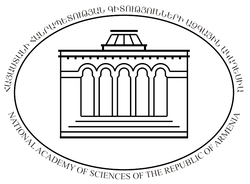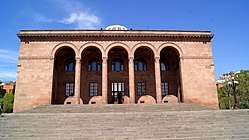Armenian National Academy of Sciences
The National Academy of Sciences of the Republic of Armenia (NAS RA) (Armenian: Հայաստանի Հանրապետության գիտությունների ազգային ակադեմիա, ՀՀ ԳԱԱ, Hayastani Hanrapetut’yan gitut’yunneri azgayin akademia) is the primary body that conducts research and coordinates activities in the fields of science and social sciences in Armenia.
 Logo of the academy | |
| Established | November 10, 1943 |
|---|---|
| President | Radik Martirosyan |
| Staff | 3,700 (63 academicians, 61 corresponding members, 335 doctors of sciences, 1,080 candidates of sciences) |
| Formerly called | Armenian Academy of Sciences |
| Address | 24 Baghramyan Avenue, Yerevan, Armenia |
| Website | www |

The Armenian Academy of Sciences
History
The academy was founded on November 10, 1943 on the basis of the Armenian Branch of the Soviet Academy of Sciences, which was established almost 10 years earlier, in 1935. Among its founders were Joseph Orbeli, Stepan Malkhasyants, Ivan Gevorkian and Victor Ambartsumian; Orbeli became the first president of the academy.
Presidents
- Joseph Orbeli (1943–1947)
- Victor Ambartsumian (1947–1993)
- Fadey Sargsyan (1993–2006)
- Radik Martirosyan (2006–present)
Structure
- Division of Mathematical and Technical Sciences
- Institute of Mathematics
- Institute of Mechanics
- Institute for Informatics and Automation Problems
- Division of Physics and Astrophysics
- Byurakan Astrophysical Observatory
- Institute of Radiophysics & Electronics
- Institute of Applied Problems of Physics
- Institute for Physical Research
- Division of Natural Sciences
- Center for Ecological Noosphere Studies
- Institute of Biochemistry
- Institute of Botany
- G.S.Davtyan Institute of Hydroponics Problems
- Scientific and Production Center Armbiotechnology
- Institute of Biotechnology Scientific and Production Center “Armbiotechnology”
- “Institute of Microbiology” Scientific and Production Center “Armbiotechnology”
- Division of Natural Sciences Microbial Depository Center
- Institute of Molecular Biology
- Institute of Physiology
- Scientific Center of Zoology and Hydroecology
- Scientific Center of Zoology and Hydroecology- Institute of Zoology
- Scientific Center of Zoology and Hydroecology- Institute of Hydroecology and Ichthyology
- Division of Chemistry and Earth Sciences
- Scientific Technological Center of Organic and Pharmaceutical Chemistry
- Institute of Fine Organic Chemistry of Scientific - Technological Center of Organic and Pharmaceutical Chemistry
- Institute of Organic Chemistry of Scientific - Technological Center of Organic and Pharmaceutical Chemistry
- Molecular Structure Research Center of Scientific - Technological Center of Organic and Pharmaceutical Chemistry
- Institute of Chemical Physics
- Institute of General and Inorganic Chemistry
- Institute of Geological Sciences
- Institute of Geophysics and Engineering Seismology after A. Nazarov
- Division of Armenology and Social Sciences
- Institute of History
- Institute of Philosophy and Law
- M. Kotanyan Institute of Economics
- Institute of Archaeology and Ethnography
- Institute of Oriental Studies
- H. Acharian Institute of Language
- M. Abeghyan Institute of Literature
- Institute of Art
- Museum-Institute of Genocide
- Shirak Armenology Research Center
- Armenian Encyclopedia Publishing House
- All Armenian Foundation Financing Armenological Studies
gollark: Well, I'm sure there's some way to JUMP to arbitrary memory addresses.
gollark: Oh bee.
gollark: I replaced my copy of the C spec with one in which undefined behavior is specified as NOT summoning nasal demons but doing other things.
gollark: This isn't HYPERCAL.
gollark: I read that the third argument allows access to the value of all the registers at the time of the problem, so I can just edit those.
See also
References
External links
This article is issued from Wikipedia. The text is licensed under Creative Commons - Attribution - Sharealike. Additional terms may apply for the media files.